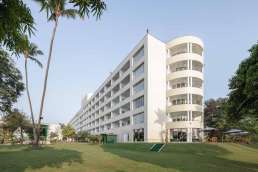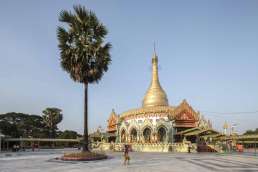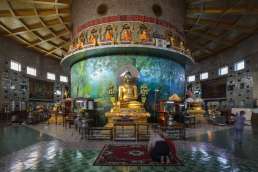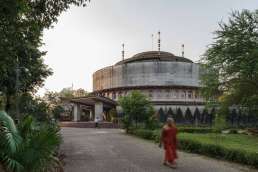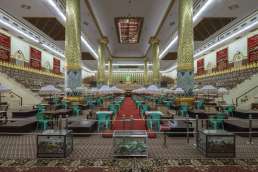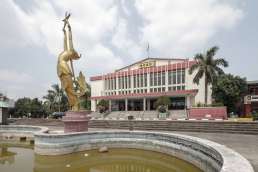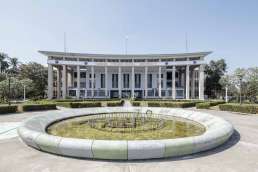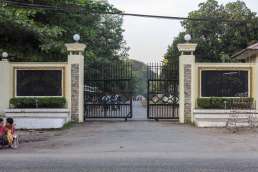Inya Lake Hotel
Address: 37 Kaba Aye Pagoda Road
Year built: 1958-1962
Architect: Viktor Andreyev and Kaleriya Kislova
The former First Secretary of the Communist Party of the Soviet Union, Nikita Khrushchev, presented the government of Burma with three gifts when he visited the country in 1958. One of these was the Inya Lake Hotel. Secluded from the traffic of the main street, its location on the shores of Inya Lake makes this a tranquil oasis. It is built in the style of a typical “sanatorium”, the rest and recreational centres you still find everywhere across the former Soviet Union. Soviet workers were allocated places in these state-run vacation centres, often located by the sea or big lakes.
The architects transported this architectural concept several thousand kilometres east to post-independence Burma, with the brief to build a resort up to international standards. Burma back then lacked a modern hotel. The Strand had seen better days and the Thamada only opened in 1964.
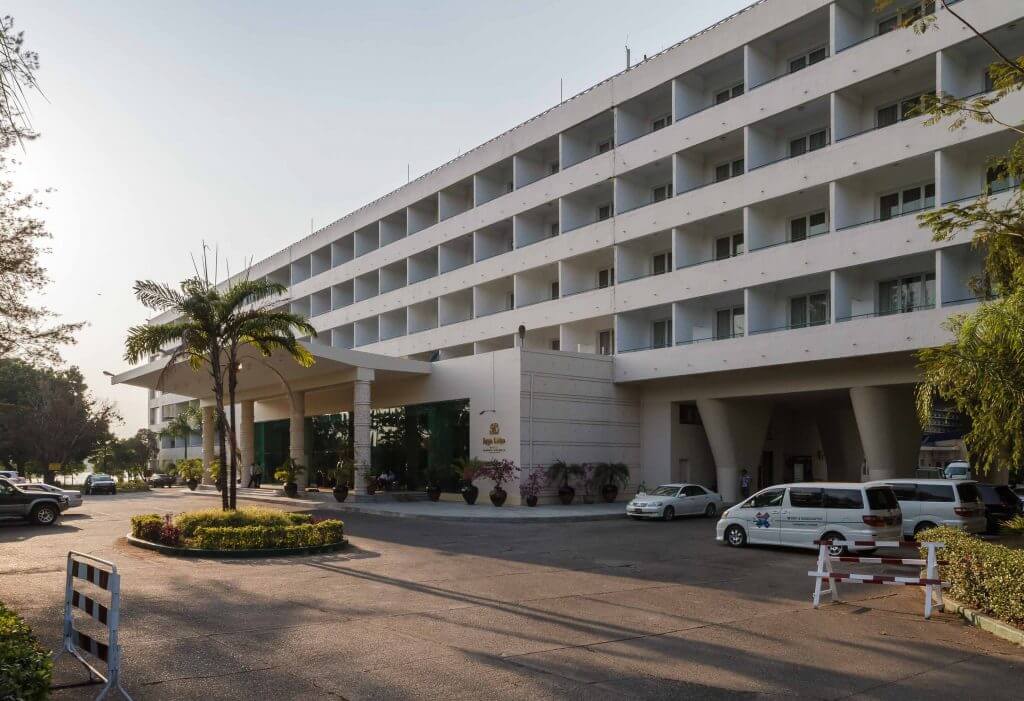
The Inya Lake Hotel has only two features that distinguish it from most Soviet sanatoria of the same period: first, the entrance is larger than usual and features a large portico above the parkway. Perhaps this is explained by local climatic realities, requiring a larger rainproof area by the main entry. Second, the imitation of a steamship funnel on the building’s top gives the hotel a peculiar, cruise ship-like impression, a playful maritime association along the lakeshore. At the back of the hotel, an annex building houses events and banquets. Its decorated, high-ceiling walls are worth observing: this would have been a “House of Culture” in the Soviet Union. These were the main public spaces for people to gather and enjoy sanctioned culture and celebrations outside their usually austere apartments. The hotel used to feature large “Inya Lake Hotel” letterings, both above the entrance and on the steamship funnel around the back.
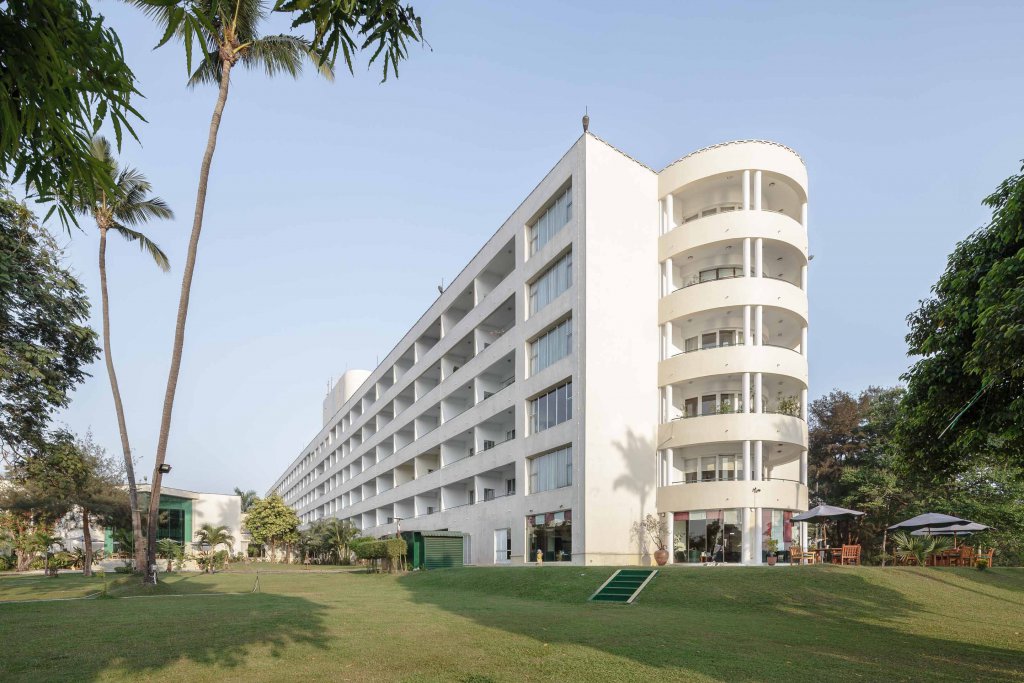
Viktor Semyonovich Andreyev (1905–1988) was a successful Soviet architect born in Kharkov, today’s Kharkiv in Ukraine. (Kharkiv preceded Kiev as the Ukrainian SSR’s capital.) He graduated from its architecture faculty in 1930. Kharkov’s Avant Garde and Constructivist architecture was very prominent, the main example being the Gosprom building complex, dating from the latter half of the 1920s. Many architects from Kharkov moved to Moscow and constituted a strong faction in the architecture profession there. Like other foreign architects introduced in this book, Andreyev’s Burma assignment was just one of several international jobs. He built USSR exhibition pavilions in Vienna and Beijing (the latter is now the Russian Embassy in China) and the Soviet Embassy in Prague. At home in Moscow, he built the Chinese Embassy among many other projects. Andreyev enjoyed high social status in the USSR. He was the recipient of many prizes: two orders of Labour Red Banner, a Stalin Prize of Third Grade, and most importantly perhaps, the People’s Architect of the USSR Prize in 1978.
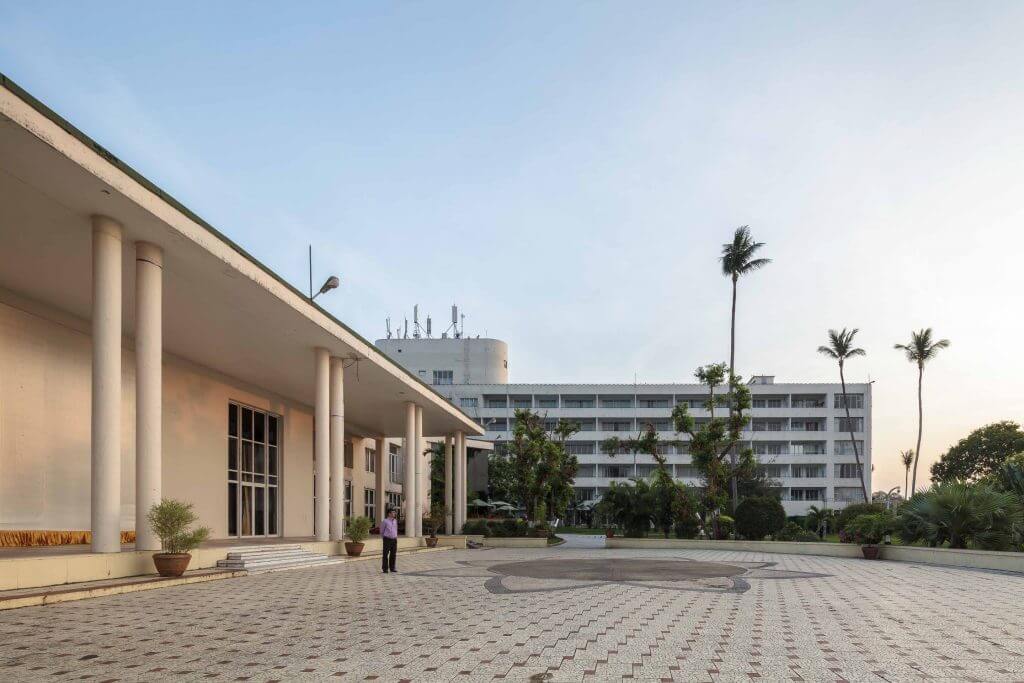
Sadly, not much is known about the second architect, Kaleriya Dmitriyevna Kislova. She is the only female architect featured in these pages and deserves as detailed a portrait as our research could muster. Her name appears in a 1950 Soviet illustrated magazine called Ogonyok. The article interviews several women in successful careers, and Kislova is shown in her design bureau, explaining that she thoroughly examined every flat in the buildings constructed according to her designs. Together, Kislova and Andreyev built the House of Political Education of the Soviet Union’s Communist Party in 1979, in Moscow. It was demolished after the Union’s collapse, perhaps because it symbolised the “poisoned” air of Communism, as historian and journalist Petr Kozma explains. Today, the same plot is occupied by an office centre that is “a tremendous monster, much uglier than its allegedly poisoned predecessor,” in Kozma’s judgement.
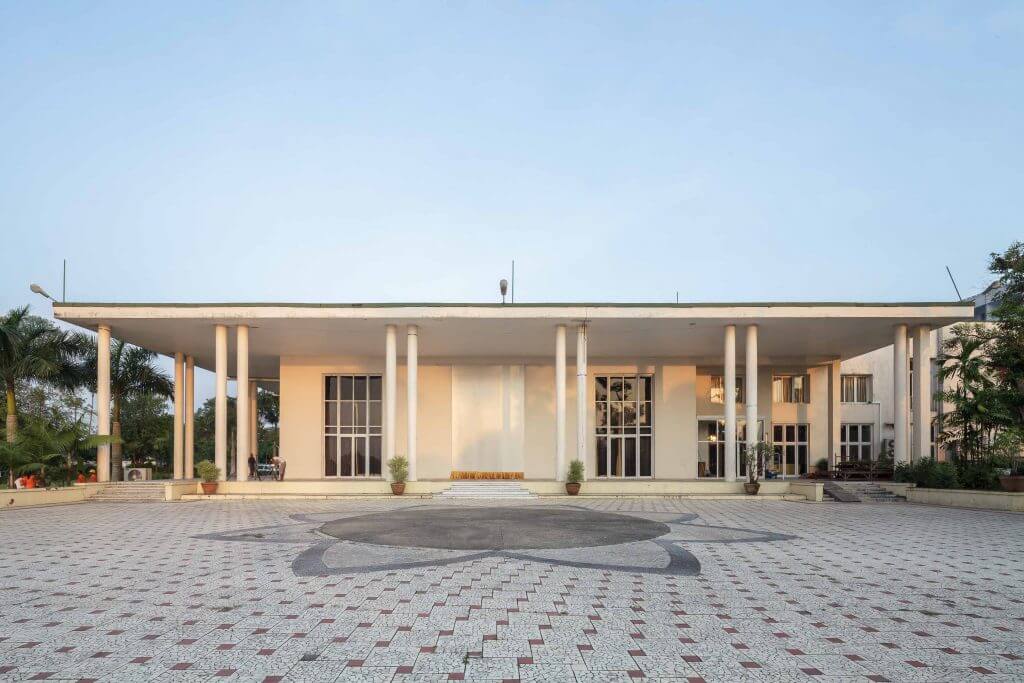
The Inya Lake Hotel was renovated and upgraded by hotelier Adrian Zecha in 1990. It was a reluctant assignment imposed on him, as we describe in our descriptions of the Strand Hotel and the Thamada which he also renovated. Zecha dismissed the Inya Lake Hotel as a “Russian bunker”. The hotel has been kept in good shape and, although it may be a little far from downtown to constitute an entirely practical place to stay, you are well advised to enjoy a cold beverage in the garden cafe overlooking the lake.
Kaba Aye Complex
Address: Kaba Aye Pagoda Road
Year built: 1952-1961
Architect: Various
Burma’s first prime minister, U Nu, was a devout Buddhist. Buddhism was also an obvious tool of nation-building after independence since an estimated 90 per cent of the country is Buddhist. In this vein, one of U Nu’s abiding legacies was his convening of the Sixth Great Buddhist Synod. This council brought together 2,500 monastics from countries practising the Theravada branch of Buddhism, including Cambodia, Laos, Myanmar, Sri Lanka and Thailand, to review and recite the scriptures written in the ancient Pali language. The synod was convened for two years, between 1954 and 1956, its conclusion coinciding with the 2,500th anniversary of the last Buddha’s demise.
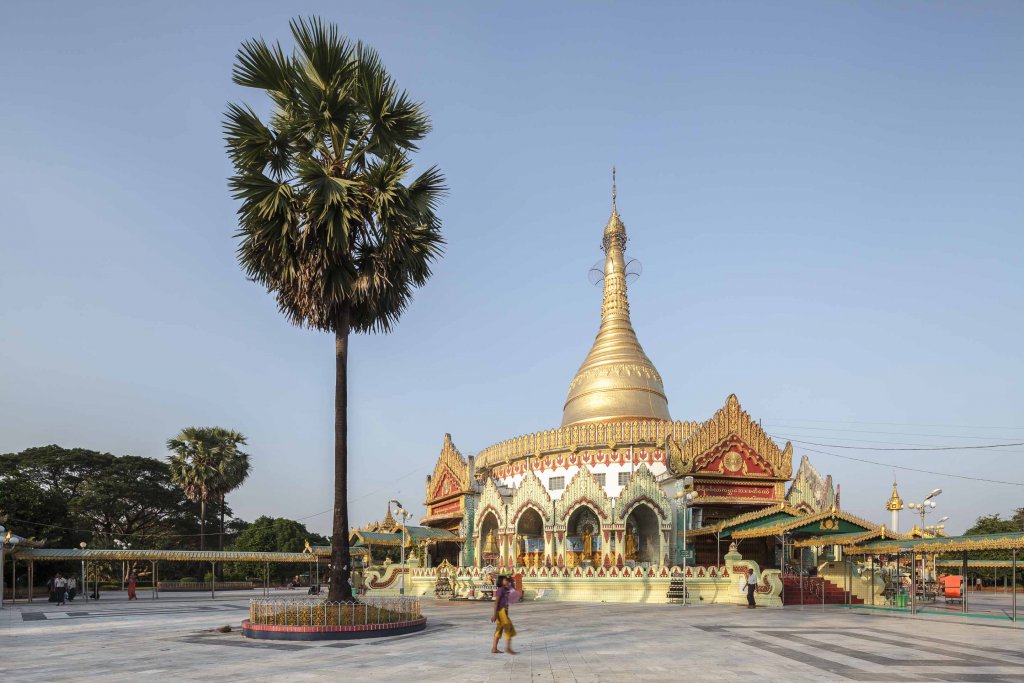
This sizeable religious compound was built for the synod. Centred around a massive man-made cave, it comprised a pagoda, a library, a hospital and hostels for the monastics. The hostels, immediately to the west of the cave, are still used by Myanmar’s most venerable monks.
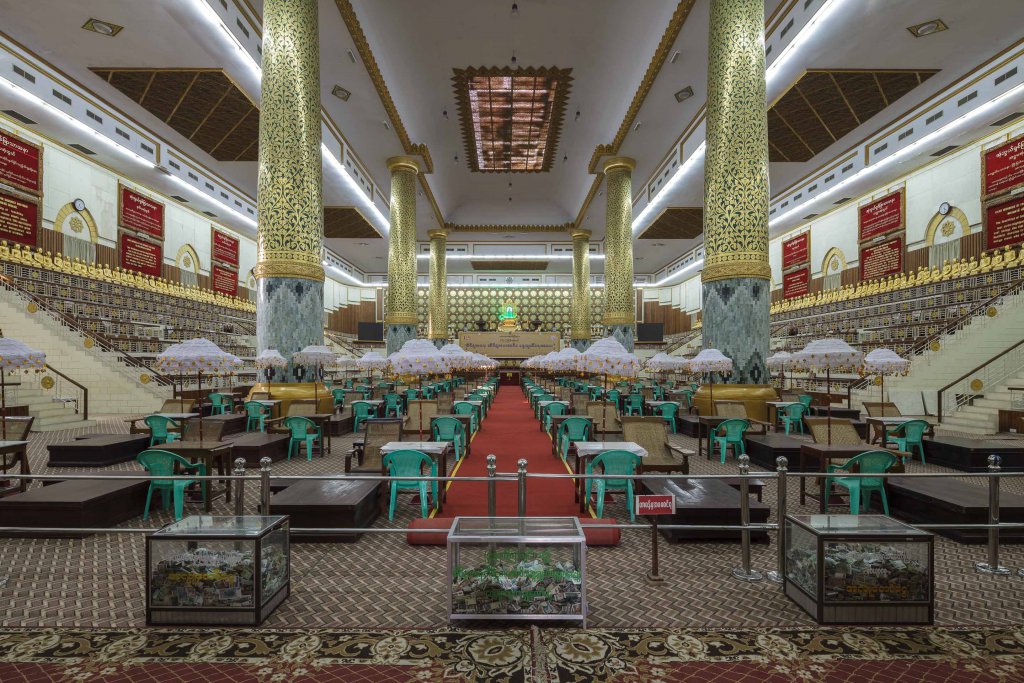
There was very little major construction taking place in the early independence period—a civil war was ravaging much of the country, even reaching the outskirts of Yangon, until it ebbed away in 1950. This makes the Kaba Aye complex’s scale all the more impressive. The Burmese parliament passed the relevant motion in 1951, stating that material improvements are “not sufficient to solve the problems of society and that measures for the spiritual and moral well-being of man could alone be effective”. Forty hectares of land were allocated to the project and 1 million pounds sterling, a stately sum for the cash-strapped country, were set aside for the construction. When the synod began in May 1954, 200,000 pilgrims gathered in the rain outside the cave to listen to the broadcast of the first day’s proceedings. Dignitaries from the participating countries sent their messages. Even two German-born monks attended the proceedings, perhaps the first non-Asians to do so in Buddhism’s long history.
Kaba Aye Pagoda (World Peace Pagoda)
Otherwise: World Peace Pagoda
Address: Kaba Aye Pagoda Road
Year built: 1952
Architect: Unknown
Of the buildings within the complex, the pagoda remains the most used today. Best begin your exploration here, as taxi drivers will have no problem finding it. Just like at the Shwedagon Pagoda, it is advisable to keep your shoes in a plastic bag and inside a backpack before entering the pagoda, as you will likely exit from another side if you venture elsewhere within the complex.

When built in 1952, the Kaba Aye stupa was a complete break from the past: worshippers were able to enter the hollow pagoda. Usually stupas were solid, with the relics buried underneath them, just like at the Shwedagon Pagoda. The Kaba Aye Pagoda’s innovation was made possible by modern construction techniques and supporting steel structures. The principle was later replicated at the Botataung Pagoda and the Maha Wizaya Pagoda. Even the Shwedagon Pagoda’s duplicate in Naypyidaw, the Uppatasanti Pagoda, is hollow. At the Kaba Aye Pagoda, the relics inside an inner chamber consist of the remains of two of the Buddha’s disciples. Before being brought to Burma, they lay in London’s Victoria and Albert Museum. The Kaba Aye Pagoda’s dimensions are rather modest: it is 34 metres high and has about the same diameter. Leave the pagoda towards the north to reach the Maha Pasana Guha.
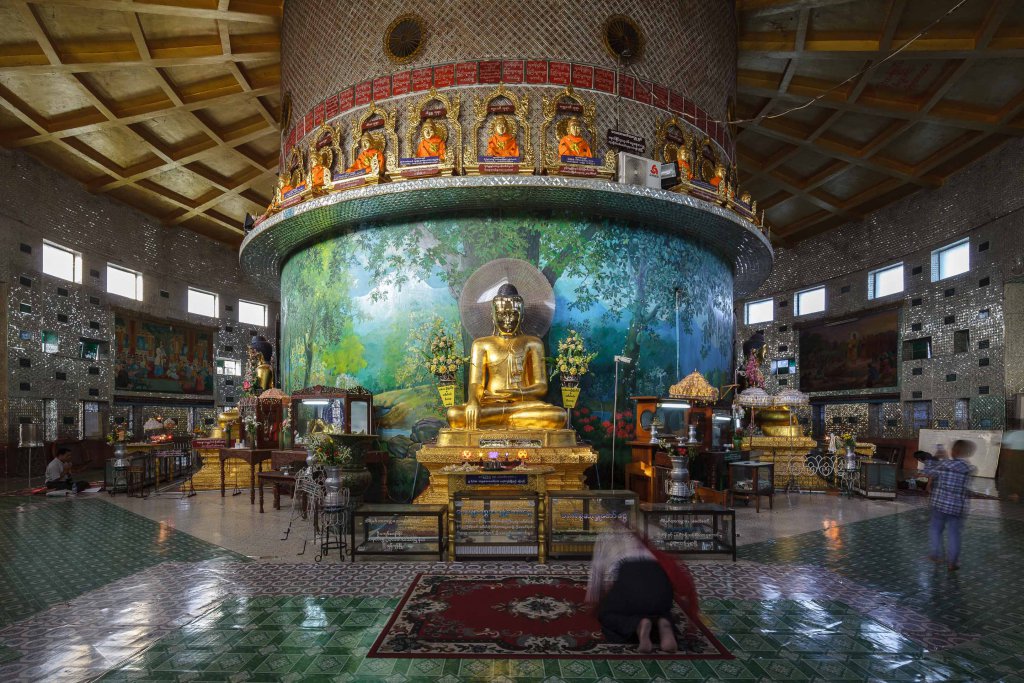
Pitaka Taik (Tripitaka Library)
Otherwise: Tripitaka Library
Address: Kaba Aye Pagoda Road
Year built: Circa 1956-1961
Architect: Benjamin Polk
Despite being part of the complex, few visitors venture far enough north to find the most interesting building of the whole complex, fenced in and looking somewhat out of bounds. In front of it is an oval pond and manicured, hilly landscape. The Burmese word “Pitaka” derives from the Pali “Tripitaka”, which translates as “Three Baskets” and denotes the canons of Buddhist scriptures. U Nu wanted a library that would store the Pali texts from the respective Theravada Buddhist countries alongside other religious writings that would emerge from the synod. For this, he commissioned an American architect.
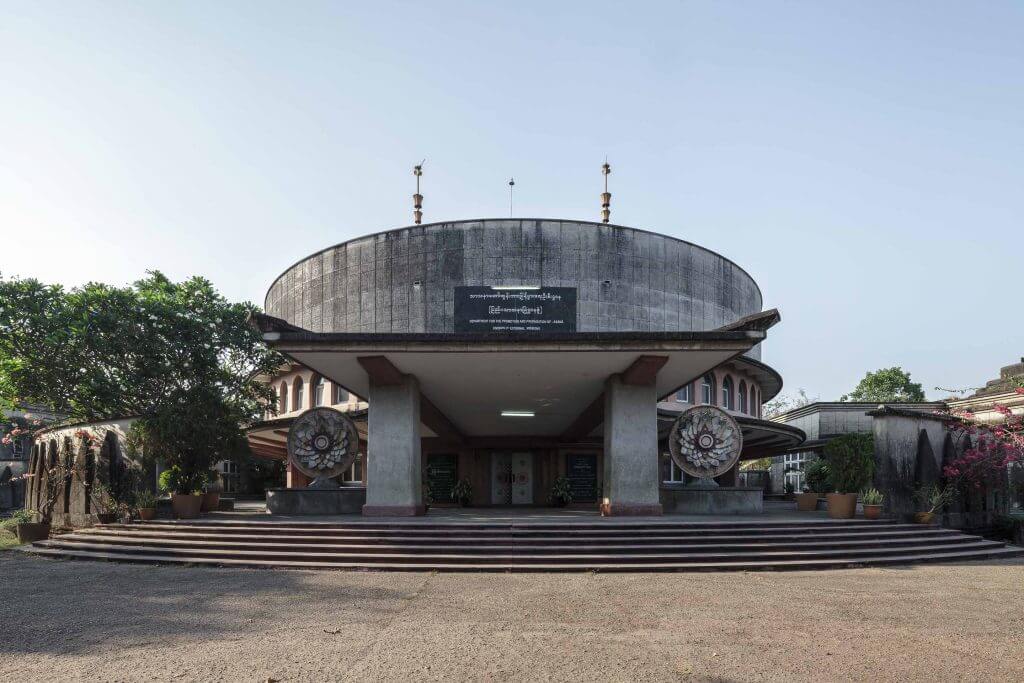
Benjamin Polk (1916–2001) had come to India in 1952 with his wife. He set up practice with fellow American Joseph Allen Stein (1912–2001) in New Delhi in 1955. (Stein had left the US due to the politically and culturally oppressive atmosphere of the McCarthy era.) The two men were later joined by Binoy Chatterjee and ran one of the largest architectural practices in Asia at the time. Together they built all over India. (Lodhi Road in New Delhi is sometimes referred to as “Steinabad” in recognition of the many buildings Stein designed there.) Polk also took assignments abroad, in Nepal for example, where he built the Royal Palace, and of course in post-independence Yangon.
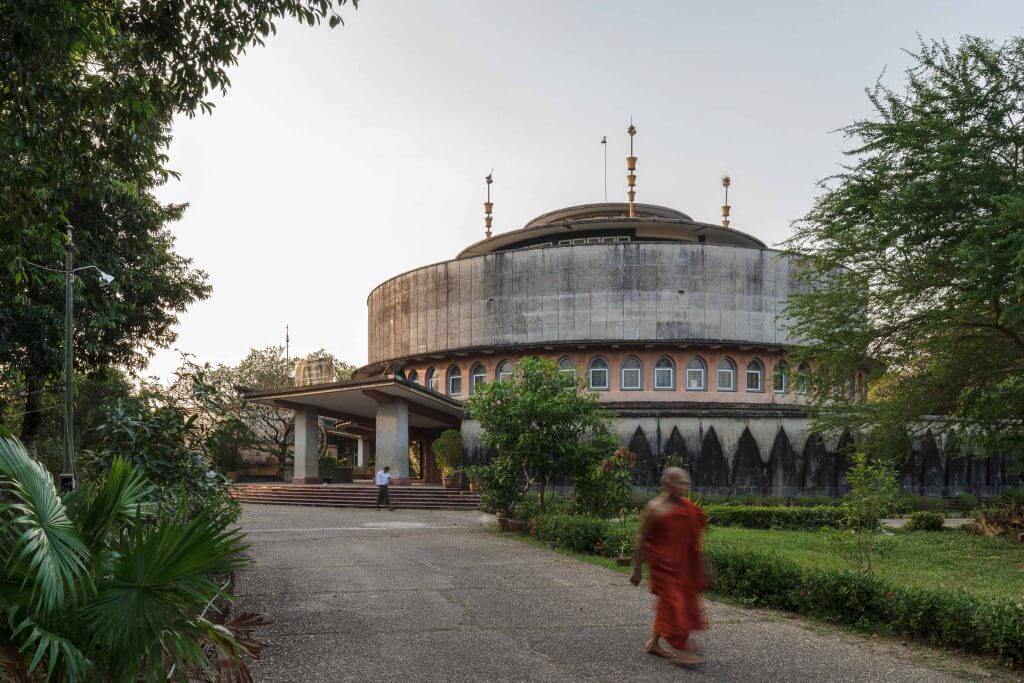
Prime Minister U Nu asked Polk to incorporate a number of highly symbolic elements and numbers into the library design. Note for example the radial design (which follows stupa architecture, above all that of the Sanchi Stupa in Madhya Pradesh, India), the building’s three storeys (after the Three Baskets of Wisdom, or Tripitaka) and the numerous lotuses. The building was to last 2,500 years, until the end of the next Buddhist epoch—quite a brief for a Modernist Western architect! But happily Polk was no dogmatist, so to speak, and proved highly sensitive to the structure’s religious and spiritual components. The material of choice was reinforced concrete. He found that the medium served the spirit of modern Burma and would allow for the building to become an heir to the architectural practices of ancient Bagan (formerly known as “Pagan”). As he explained:
“The traditional Burmese pointed arch from Pagan would now partake of the nature of reinforced concrete with its capacity to resist tension in bending. It would incorporate the structural continuity of reinforced concrete tank design, but cantilevered. Thus the interior arches of the Library could be bound in the central position of the building like the stamen and pistil forms of a flower. Here the uniformly pyramidal silhouettes of Pagan would be punctuated with the cantilever, partially hidden, but giving the weight of the building a dynamic upward and outward thrust behind the encircling walls. Perhaps there is something ‘primitive’ here.”
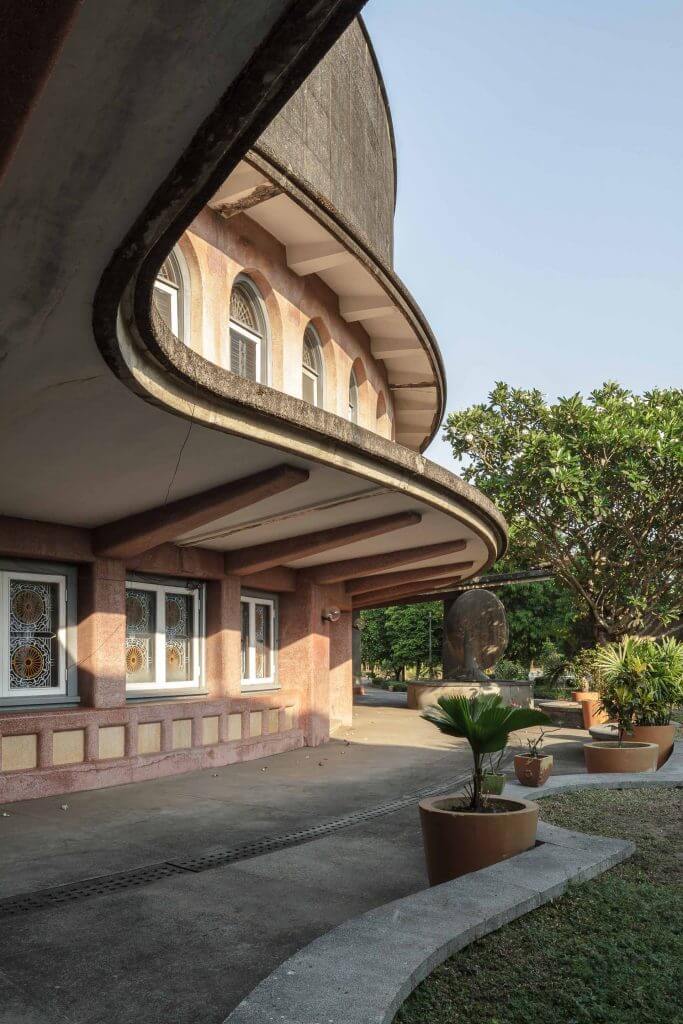
The library was designed with three wings, containing a public library, an auditorium and a religious museum respectively. The central core of the building would be reserved for scholars and monks of the institute, as a sanctuary for study and meditation. An Indian site manager named Visvanath Jhanjee oversaw the construction process. It was to take five years and ran into its own set of problems. An ethnic Chinese carpenter foreman was murdered. The first site engineer had to be removed from the job after he was found to have a drinking problem. The “political vicissitudes” of the times also plagued U Nu’s pet project, as Ne Win replaced him as prime minister between 1958 and 1960. We therefore date the start of the construction between 1955 or 1956 (the latter being the end of the Sixth Synod) and 1960 or 1961, by which time U Nu had won back this prime ministerial post. U Nu was also present at the inauguration ceremony and served the architects the first two dishes of its banquet. A Soviet publication at the time credits the library to both Polk and Stein, although Polk makes no mention of his partner’s involvement in Yangon.
This building is magical. With its bold architectural design, it conveys the bygone optimism of a young Buddhist nation.
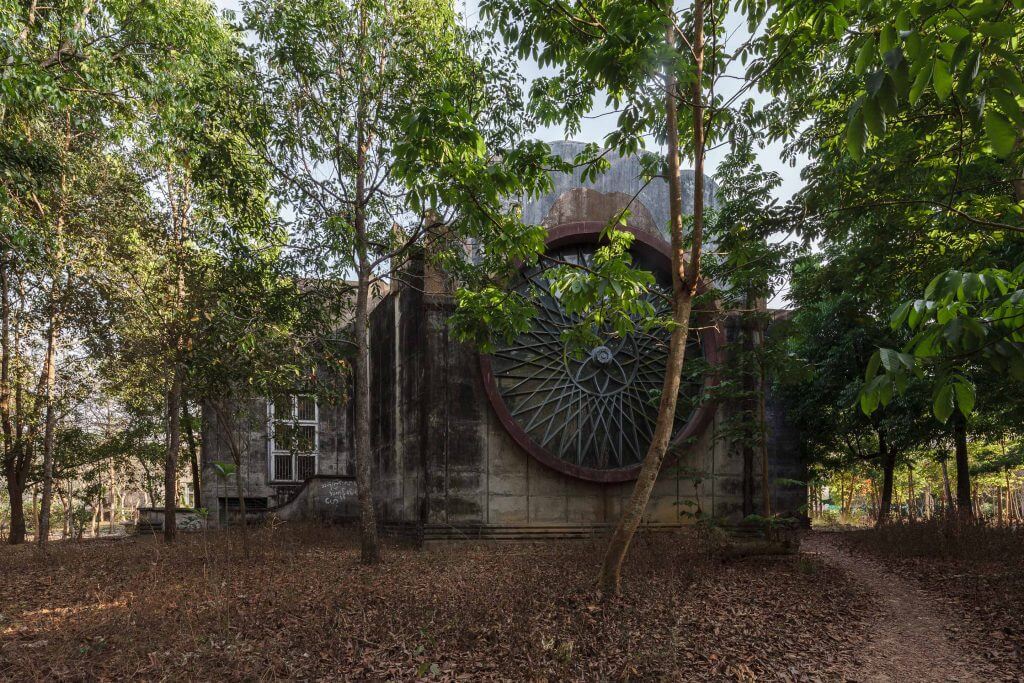
Maha Pasana Guha (Great Cave)
Otherwise: Great Cave
Address: Kaba Aye Pagoda Road
Year built: 1953-1954
Architect: Unknown
The convention of the synod was held here, a cave inside an artificially created rock. Its construction consumed 12,000 tons of cement and 380 tons of steel. The dimensions are equally impressive: the outside structure is 140 metres long and 110 metres wide. Inside, the assembly hall is 70 metres long and 40 metres wide. This created capacity for about 7,500 spectators to join the 2,500 monastics. Six entrances admitted people back then, signifying the Sixth Great Buddhist Synod. The cave was completed in 14 months, thanks in no small part to thousands of volunteer labourers.

Allegedly, U Nu was inspired to commission the cave as the centre of the synod following an earlier visit to the Satta Panni Cave in India, where the First Great Buddhist Synod was held the year after the Buddha’s passing. Today the cave is surrounded by trees. When the synod was held, however, it was almost entirely bare and its scale therefore easier to appreciate. The cave can be visited, the main entrance is on the southern side. It is still used for religious ceremonies. Given the precious little traffic around here, locals use the road surrounding the cave for their workout routines.
Nawaday Cinema
Address: Kaba Aye Pagoda Road
Year built: 1990
Architect: Unknown
Near the Kaba Aye Pagoda complex, the Nawaday Cinema is an arresting example of SLORC-era architecture for the entertainment industry. The contrast with the handful of cinemas downtown—from the colonial Waziya to the 1950s and 1960s-built cinema/hotel, the Thamada, for example—could not be starker.
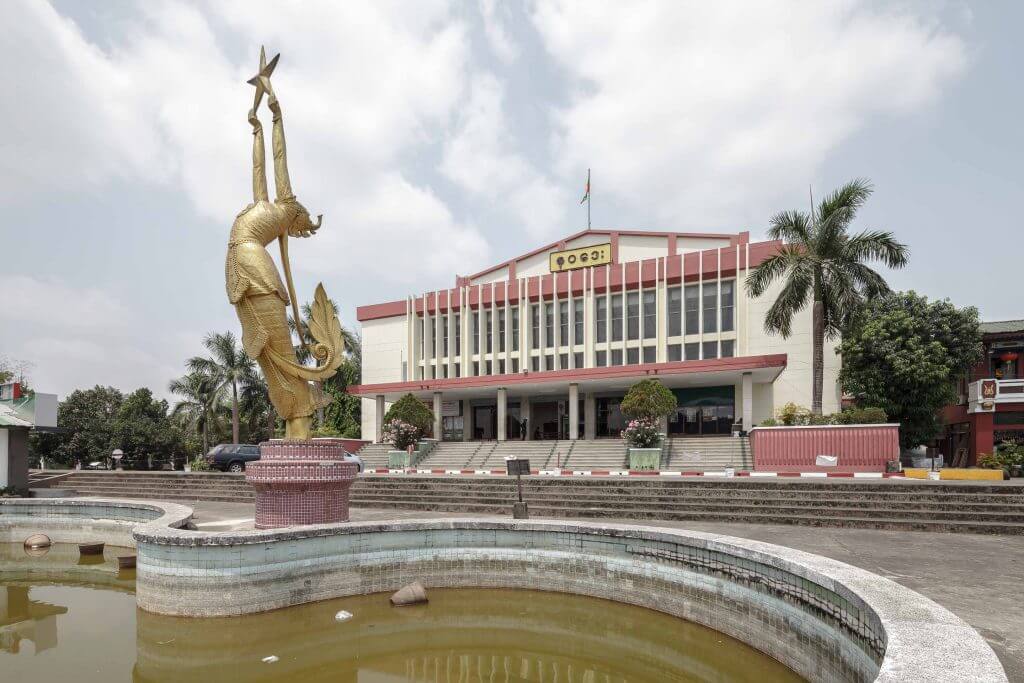
If the architectural feel of those theatres immediately evokes the colonial era, in the case of the Waziya; or the enterprising optimism of the 1950s for the Thamada, then the Nawaday Cinema’s isolated location, self-contained park, expansive dimensions and swaggering golden statue reflect an entirely different vision of the city and the built environment.
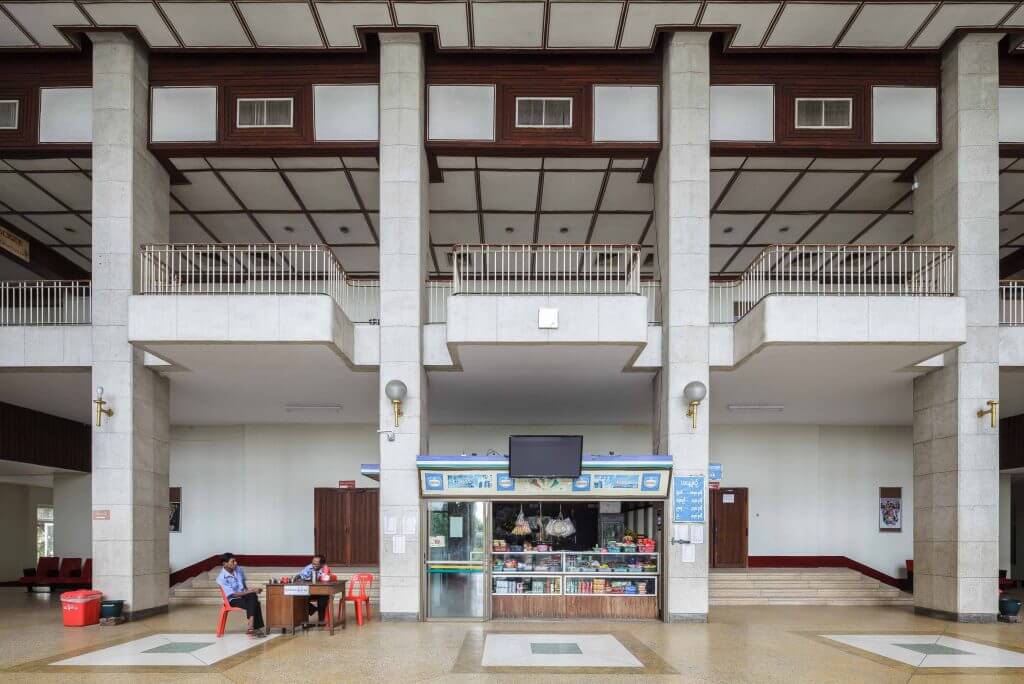
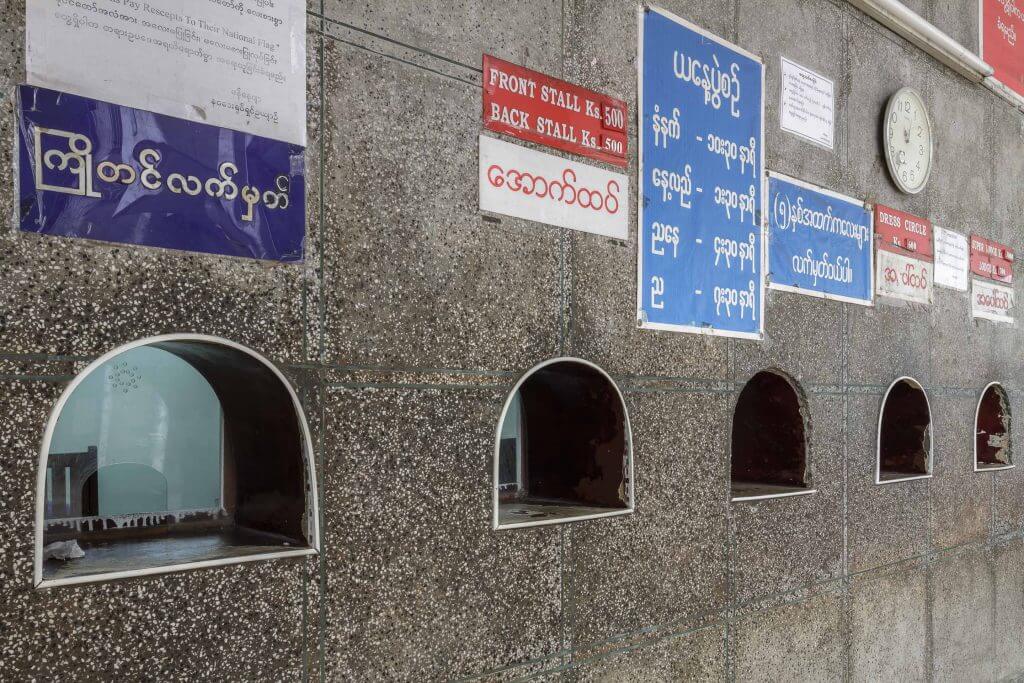
In that sense, the Nawaday Cinema was clearly a SLORC production. Its construction required the resettlement of more than 20,000 people that lived on the large complex, according to some sources. The cinema’s vast, rectilinear atrium and lobby would not look out of place in Naypyidaw. The trappings of government officialdom are clear in the grandiose statue out front too—a large replica of the Myanmar Academy Awards trophy. (On the other hand, the pediment crowning the building owes more to the city’s colonial heritage.) A private operator has been leasing the venue since 1997. A Chinese restaurant specialising in shark-fin soup also occupies the premises.
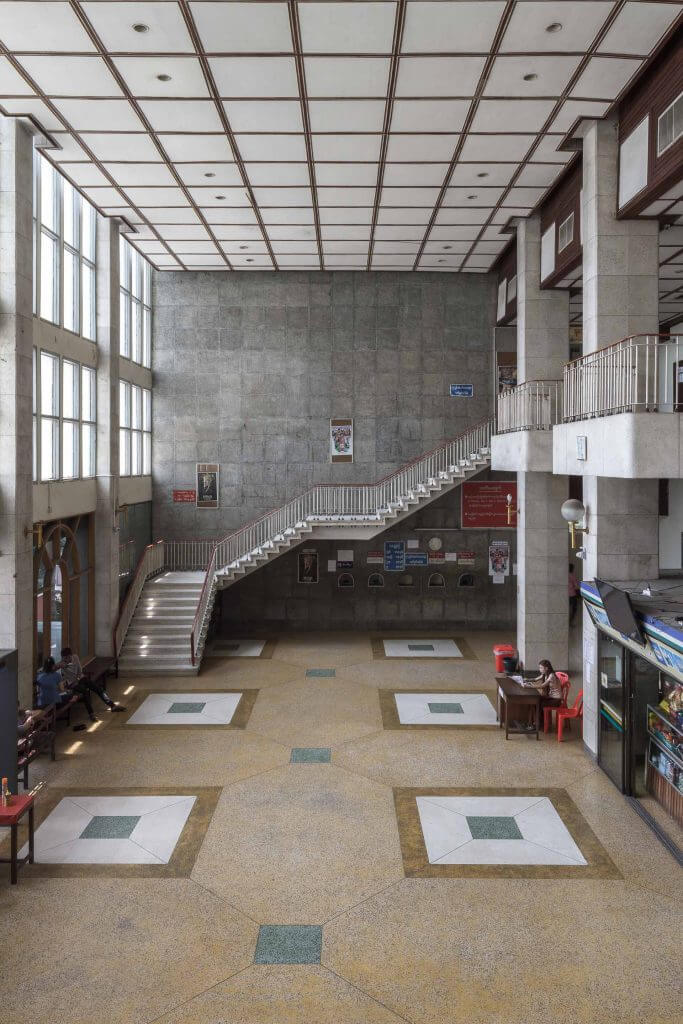
Yangon Technological University
Formerly: Rangoon Institute of Technology
Address: Insein Road
Year built: 1958-1961
Architect: Pavel Stenyushin
This major university campus was another gift from the Soviet Union. The Engineering College of Rangoon University moved here upon its completion in 1961. Prior to that, it was housed in the Engineering College, today’s University of Medicine-1 designed by Raglan Squire, which had only been finished a few years before in 1956. Interestingly, the biographies of both Squire (1912–2004) and the Soviet architect, Pavel Stenyushin (1904–1971), have significant parallels. Stenyushin and Squire were each involved in their countries’ reconstruction efforts after the Second World War. Squire planned the conversion of townhouses into apartments in London’s Belgravia, while Stenyushin worked for Mosarkhitektura and designed the city centre of Kursk, a Soviet city almost completely razed during the war. In Kursk, Stenyushin built two pompous buildings on the central Red Square, a hotel and the City Council; both have Neoclassical and more pure Stalinist architectural features. Before the war, Stenyushin also designed a massive “General’s House” on Moscow’s Leningrad Avenue. And just like Squire, he made a name for himself abroad. His Technological University in Yangon preceded later international assignments including the Polytechnic University in Kabul. Political systems and architectural styles divided these men, but their work took eerily parallel paths.
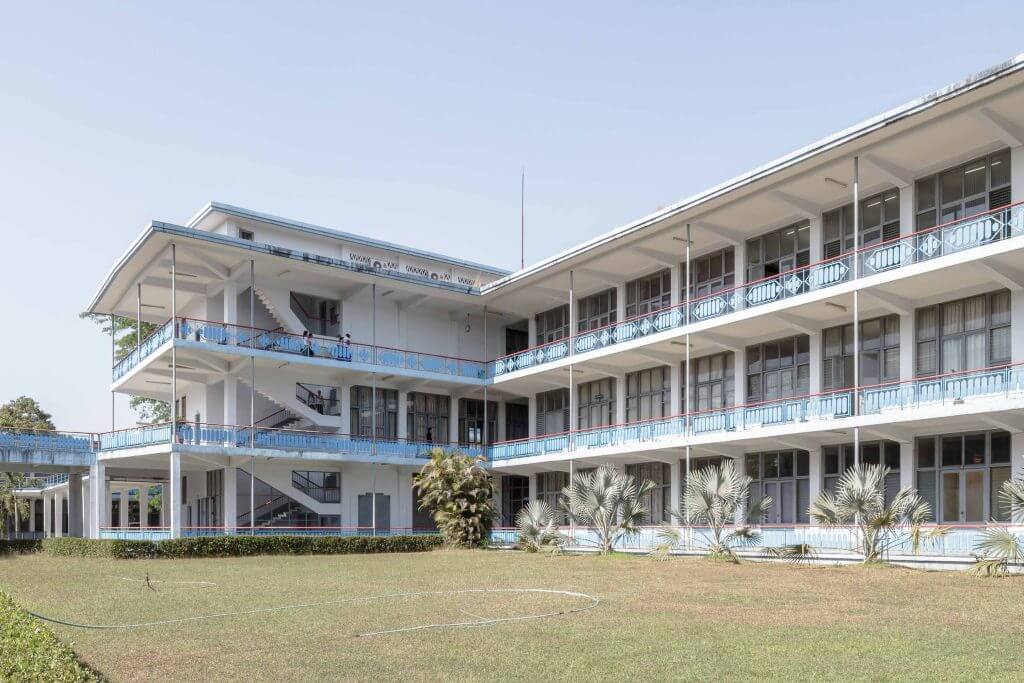
Both brought their aesthetics to Burma but had to adapt to local climatic realities. This led to some similarities in their work, for example the covered walkways and exterior-facing corridors. The main building of the Technological University features an imposing colonnade and large protruding roofs. This peculiar shape explains why some students called this the “university under the table”. Its slightly concave form harmonises with the circular plaza which it concludes towards the north, featuring a large water fountain at its centre. A series of courtyards and open staircases create an airy atmosphere inside the various buildings. Perforated walls perform a similar function. Plaques in Russian and Burmese are placed inside the central columns of the colonnade and commemorate the laying of the foundation stone by former Burmese President U Win Maung on 21 April 1958. Three years later, students moved to this location, rather far away from the centre. Some felt sentimental about the new setting. As one of them—U Myint Khine—recalls:
“On our first day, with renewed hope and vigour, and a feeling of great anticipation, I made my way through the huge, lofty columns of the main entrance. But, I must confess, in all honesty, that I felt a little bit disappointed. The architecture was, if anything, imposing. It was extremely functional, but to me, it was a bit too sterile.
The old Faculty of Engineering buildings we left behind were somewhat airy and light in comparison. The Burmese murals decorating the various façades were a joy to behold during our classroom breaks. The whole aspect was aesthetically very pleasing. All this flashed through my mind as I entered [Rangoon Institute of Technology], but I quickly put it out of my system. Whether pleasing in appearance or not, as I remarked before, it was still functional and solidly designed. If this is the ‘altar’ where I must gain my final ‘rites of passage’ into the world of Engineering, so be it. I will grow to love it and indeed I truly did in the end.”
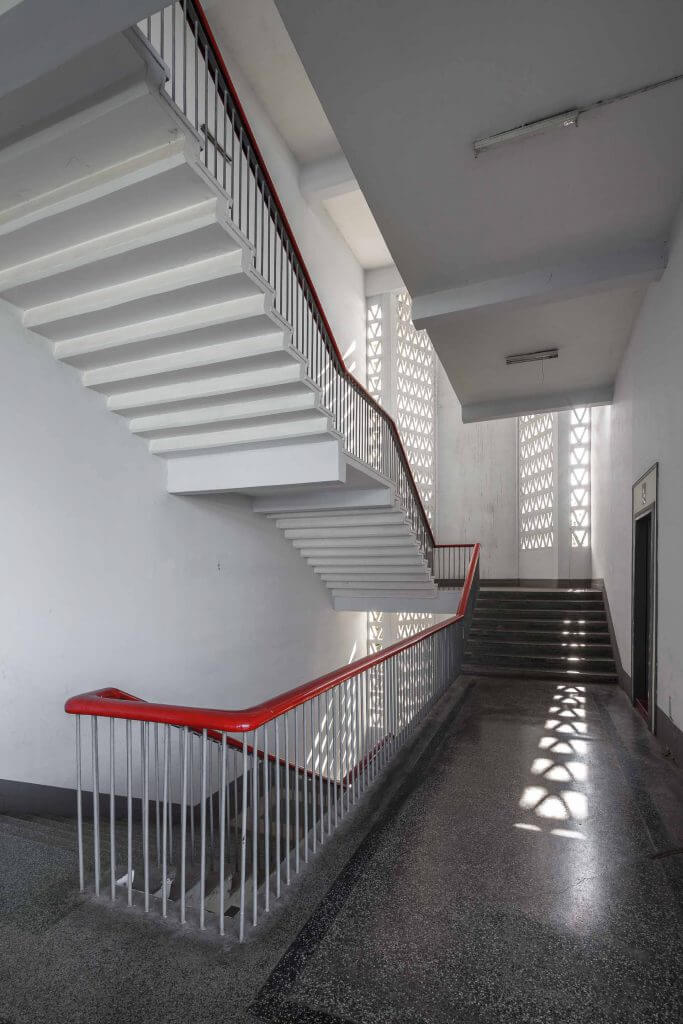
The Soviet Union was among the first countries to recognise independent Burma. But things got off to a rocky start as the Soviets backed communist anti-regime forces in their fight against the government in Yangon. Embassies in both countries only opened in 1951. By 1955, relations had warmed considerably. Prime Minister U Nu went on a two-week tour of the Soviet Union and Eastern Europe, signing trade deals and technical cooperation agreements. Burma pledged to support Soviet foreign policy, including backing Communist Chinese membership of the UN (at that time, Taiwan still represented China there). A high-level Soviet delegation visited Burma in 1955 and Rangoon’s population was told to line the streets and cheer the motorcade. It was during this visit that the agreement to build the Rangoon Institute of Technology was agreed in principle. Three years later, on Khrushchev’s next visit, it was officially presented as a gift of the Soviet people.
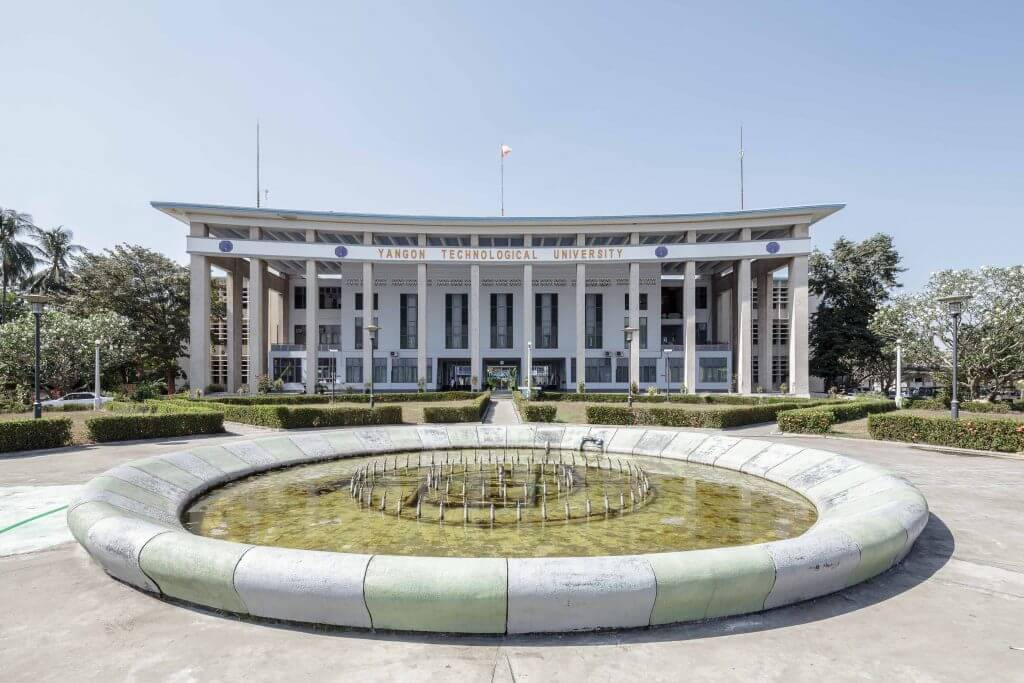
Burma’s embrace of the Soviet Union was pragmatic. It was finding it difficult to sell large quantities of surplus rice on the world markets, and the Soviet Union was an important buyer—although payment was often in kind. US intelligence was worried that “Communist trade, Communist experts and Communist-designed and erected buildings could be followed by Communist arms, Communist ideas, and ultimately, Communist control of this country”. When Ne Win took over power in a military coup in 1962, the socialist period of Burmese post-independence history dawned. But in its Ne Win vintage, this socialism took the country on an inward-looking and isolationist path.
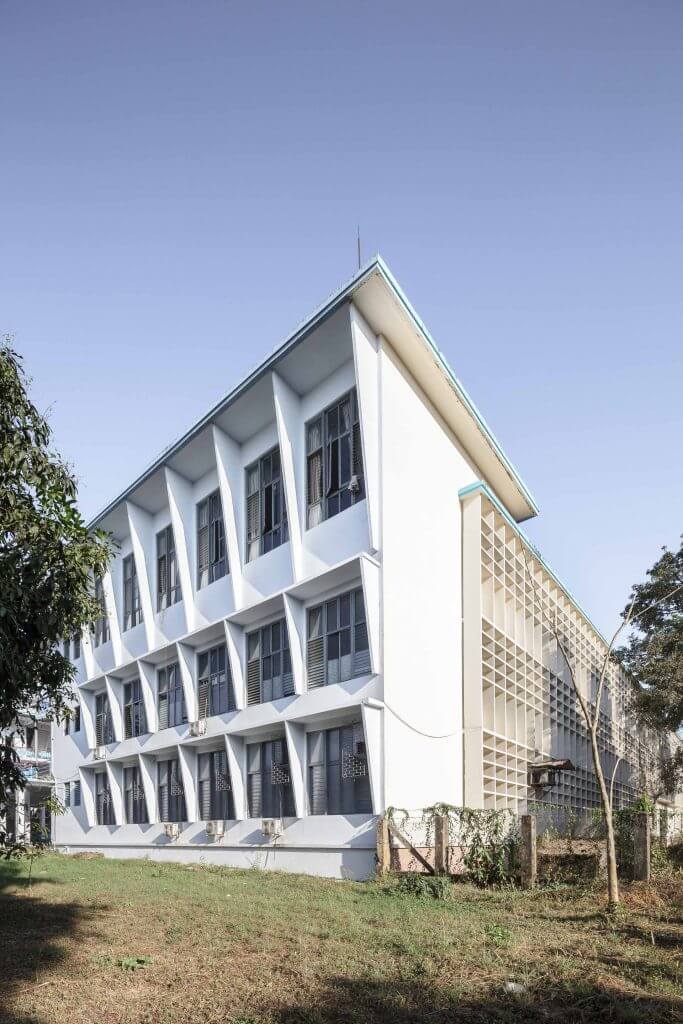
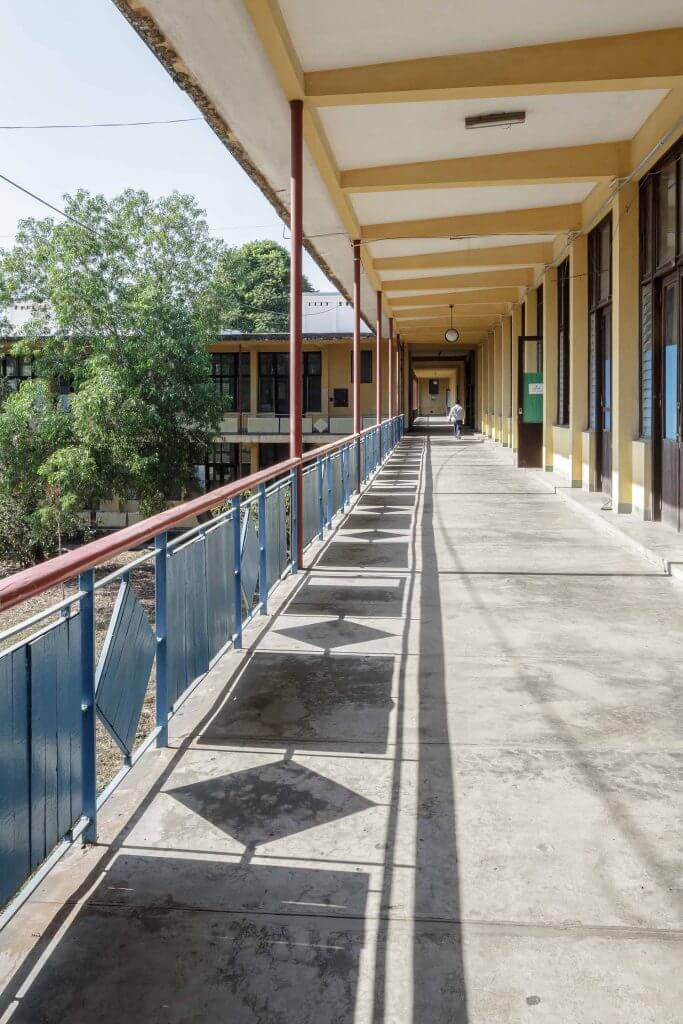
Yangon Correctional Facility
Formerly: Insein Prison
Address: Main entrance on Hlaing River Road
Year built: 1887 (with later additions)
Architect: Unknown
Despite the government’s claims to have released the country’s remaining political prisoners (which is disputed—in fact, the UN Special Rapporteur for Human Rights in Myanmar believes they are jailing new ones), this building retains the haunting aura of its darkest days. Many pro-democracy activists were incarcerated here after the 1988 uprising, often in inhumane and squalid conditions. Insein Prison became known throughout the world as the ultimate symbol of the junta’s repression.
The origins of the correctional facility go back to the late 19th century. By that time, Insein was still only a small town, about 15 kilometres north of downtown Rangoon. The new prison here was intended to relieve the Rangoon Central Gaol (“gaol” being the more commonly used British spelling for “jail” during the period), which was reaching full capacity. By 1908, both Insein and Rangoon jails were by far the biggest in British Burma, with more than 2,000 inmates each. The Inspector-General of Prisons in Burma at the time reported proudly that growing inmate populations were proof of effective law enforcement. But by the 1920s, Burma had developed a reputation for being the most violent part of British India. With a population of 13 million, the government sent about 20,000 men to prison each year (women were also imprisoned, but their numbers usually stayed below 5 per cent of the total number of convicted men), which was four times the average of British India as a whole. This, needless to say, led to overcrowded prisons and further building works were needed to extend their capacity. By 2009, Insein Prison had space for about 5,000 to 6,000 inmates; however, an estimated 10,000 prisoners were being held here.
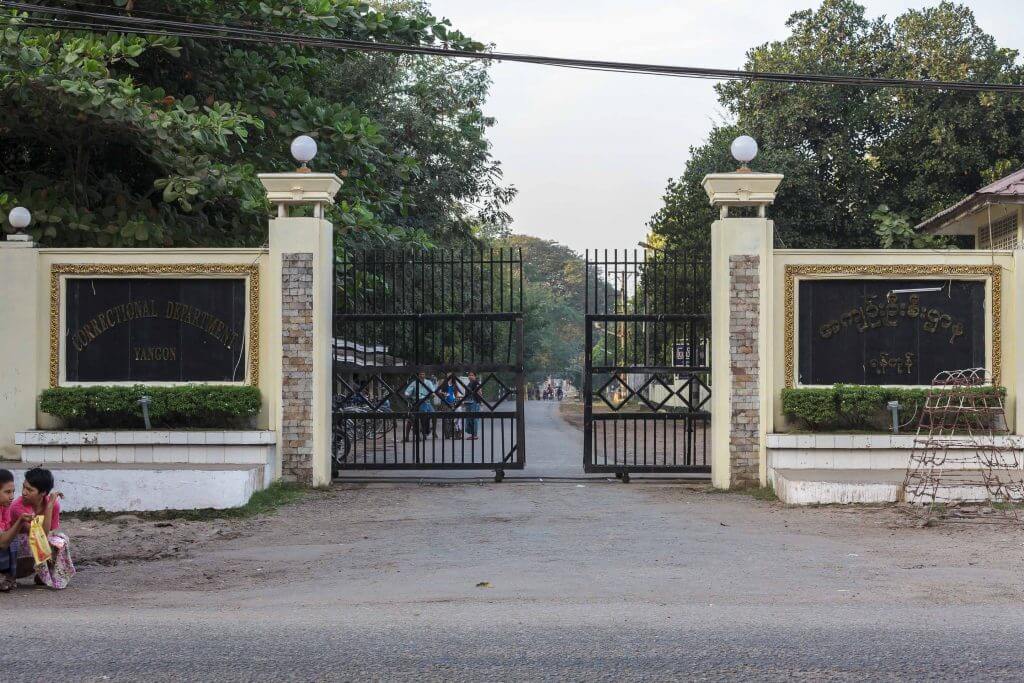
The architecture of Insein Prison closely follows the so-called Pentonville model, based on the late 18th-century theories of Jeremy Bentham, who proposed penitentiary designs hiding the jailer from the prisoners’ sight, encouraging “the sentiment of a sort of omnipresence”. Located in north London and built in 1842, the prison revolutionised correctional facilities in 19th-century Britain, with reverberations across the Empire. Confronted with a growing inmate population and a move away from the idea of “punishment” towards the “reform” of prisoners (whether that was systematically achieved in practice is another question), the main features of these new-generation prisons were: a structure of building wings revolving around a central observation tower; walls between prison cells hindering communication between inmates; and workshops allowing prisoners to learn a trade while in confinement.
The Rangoon Central Gaol was demolished some time after the war (its former site is where the New General Hospital is located now, just north of Bogyoke Road) and Insein Prison became the main correctional facility for the capital region. Its notoriety grew with the government’s growing reputation for brutality. During Ne Win’s reign (1962–1988), undesirable political opponents were regularly put away here—including architect U Kyaw Lin, who built the Thakin Kodaw Hmaing Mausoleum among many other projects. Later, with the student protests, these numbers swelled dramatically. The horrors experienced by the inmates are difficult to fathom. Punishments included solitary confinement for extended periods, torture and denial of medical care. Sanitary conditions were unbearable. Several former political prisoners have discussed their experiences in writing. One former political prisoner, Dr Ma Thida, named her memoirs Sanchaung, Insein, Harvard to illustrate her trajectory from a Yangon youth to the prestigious halls of an Ivy League university—and the traumatic years in between, from 1993 to 1999, when she became a cause celebre of human rights groups. Other former political prisoners work full-time to expose injustices in the regime’s penal system. Based in the border town of Mae Sot, Thailand, the Assistance Association for Political Prisoners (Burma) (AAPP) lobbies to support political prisoners and honours the memories of those who died behind bars. Their offices contain a replica of an Insein jail cell and a miniature model of the correctional facility.
Insein Prison is, of course, inaccessible to outsiders. The main gate leads to several checkpoints visitors must pass before reaching the compound. But you may get a chance to study the prison’s layout from your aeroplane seat. If leaving Yangon by plane in a westerly direction, those sitting on the right may well catch a glimpse of the prison beneath them, even at night. Its radial design stands out.
In early 2015, the AAPP estimated that there were still about 160 political prisoners in Myanmar, most of them within the walls of Insein Prison.
